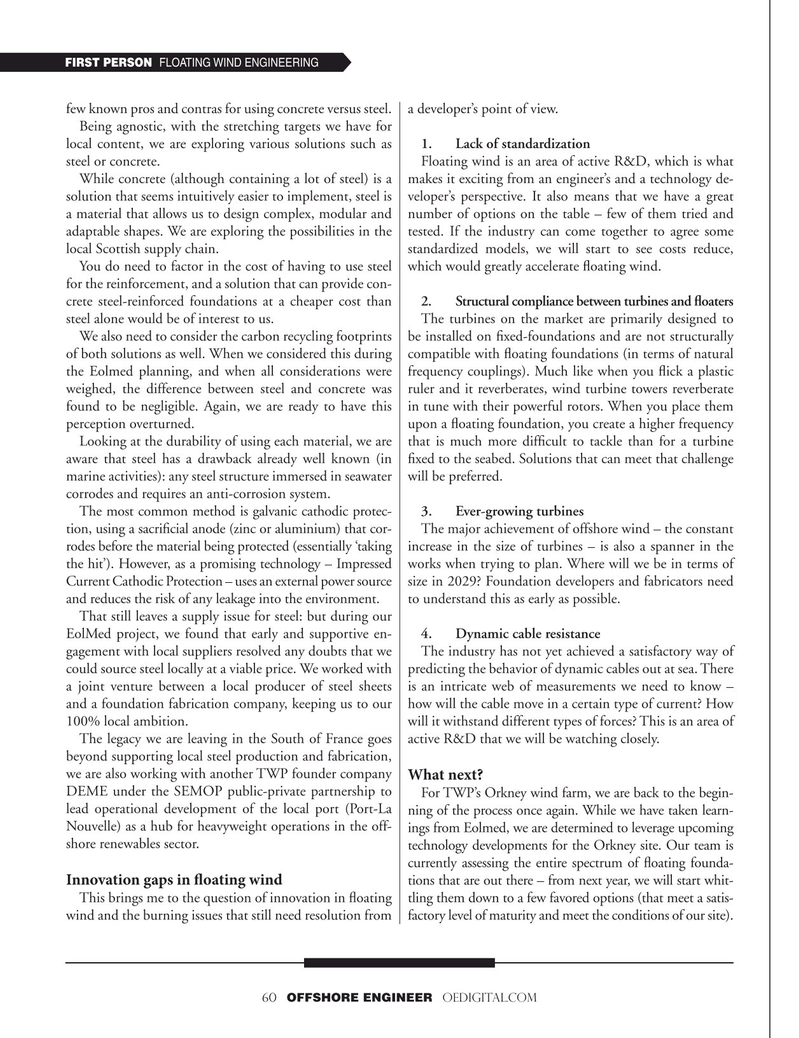
Page 60: of Offshore Engineer Magazine (Mar/Apr 2023)
Read this page in Pdf, Flash or Html5 edition of Mar/Apr 2023 Offshore Engineer Magazine
FIRST PERSON FLOATING WIND ENGINEERING few known pros and contras for using concrete versus steel. a developer’s point of view.
Being agnostic, with the stretching targets we have for local content, we are exploring various solutions such as 1. Lack of standardization steel or concrete. Floating wind is an area of active R&D, which is what
While concrete (although containing a lot of steel) is a makes it exciting from an engineer’s and a technology de- solution that seems intuitively easier to implement, steel is veloper’s perspective. It also means that we have a great a material that allows us to design complex, modular and number of options on the table – few of them tried and adaptable shapes. We are exploring the possibilities in the tested. If the industry can come together to agree some local Scottish supply chain. standardized models, we will start to see costs reduce,
You do need to factor in the cost of having to use steel which would greatly accelerate foating wind.
for the reinforcement, and a solution that can provide con- crete steel-reinforced foundations at a cheaper cost than 2. Structural compliance between turbines and foaters steel alone would be of interest to us. The turbines on the market are primarily designed to
We also need to consider the carbon recycling footprints be installed on fxed-foundations and are not structurally of both solutions as well. When we considered this during compatible with foating foundations (in terms of natural the Eolmed planning, and when all considerations were frequency couplings). Much like when you fick a plastic weighed, the difference between steel and concrete was ruler and it reverberates, wind turbine towers reverberate found to be negligible. Again, we are ready to have this in tune with their powerful rotors. When you place them perception overturned. upon a foating foundation, you create a higher frequency
Looking at the durability of using each material, we are that is much more diffcult to tackle than for a turbine aware that steel has a drawback already well known (in fxed to the seabed. Solutions that can meet that challenge marine activities): any steel structure immersed in seawater will be preferred. corrodes and requires an anti-corrosion system.
The most common method is galvanic cathodic protec- 3. Ever-growing turbines tion, using a sacrifcial anode (zinc or aluminium) that cor- The major achievement of offshore wind – the constant rodes before the material being protected (essentially ‘taking increase in the size of turbines – is also a spanner in the the hit’). However, as a promising technology – Impressed works when trying to plan. Where will we be in terms of
Current Cathodic Protection – uses an external power source size in 2029? Foundation developers and fabricators need and reduces the risk of any leakage into the environment. to understand this as early as possible.
That still leaves a supply issue for steel: but during our
EolMed project, we found that early and supportive en- 4. Dynamic cable resistance gagement with local suppliers resolved any doubts that we The industry has not yet achieved a satisfactory way of could source steel locally at a viable price. We worked with predicting the behavior of dynamic cables out at sea. There a joint venture between a local producer of steel sheets is an intricate web of measurements we need to know – and a foundation fabrication company, keeping us to our how will the cable move in a certain type of current? How 100% local ambition. will it withstand different types of forces? This is an area of
The legacy we are leaving in the South of France goes active R&D that we will be watching closely.
beyond supporting local steel production and fabrication, we are also working with another TWP founder company
What next?
DEME under the SEMOP public-private partnership to
For TWP’s Orkney wind farm, we are back to the begin- lead operational development of the local port (Port-La ning of the process once again. While we have taken learn-
Nouvelle) as a hub for heavyweight operations in the off- ings from Eolmed, we are determined to leverage upcoming shore renewables sector.
technology developments for the Orkney site. Our team is currently assessing the entire spectrum of foating founda- tions that are out there – from next year, we will start whit-
Innovation gaps in foating wind
This brings me to the question of innovation in foating tling them down to a few favored options (that meet a satis- wind and the burning issues that still need resolution from factory level of maturity and meet the conditions of our site). 60 OFFSHORE ENGINEER OEDIGITAL.COM

 59
59

 61
61